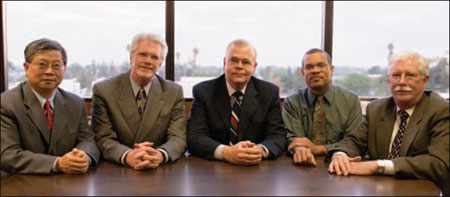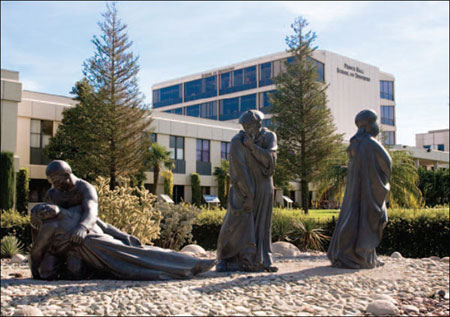Loma Linda University School of Dentistry
Loma Linda, California
Interviewees:
Charles J. Goodacre, DDS, MSD, Dean
Ron Forde, DDS, Director, Service Learning
Yiming Li, DDS, PhD, Director, Center for Dental Research Ronald Dailey, PhD, Associate Dean, Academic Affairs
William Hooker, PhD, MFCC, Associate Dean, Student Affairs
INSIDE DENTISTRY: Your dental school’s motto is “Service is our calling.” Can you explain what this means to you and how you think your school differentiates itself from the other dental schools in the United States?
DR. RON FORDE: Our School of Dentistry was established over 50 years ago, in part to graduate a stream of dentists and dental hygienists who would regard their work as service to their communities. Excellence in the academic arena linked with clinical competence would define the dental curricula, providing the graduating dentist with the best tools to serve the patient’s needs. The patient would be the focus of all clinical experiences. That is to say that the rewards of the profession would come from the giving rather than from the getting. Remember Churchill’s dictum: “We make a living by what we get, we make a life by what we give.”
To this end, the School’s motto is incorporated in our outreach opportunities both locally and internationally. As in most dental schools in the United States today, there are clinical rotations built into the curricula through which students serve their local communities. Beyond this, LLUSD is able to rotate more than 100 students annually to approximately 20 countries. This is possible because there is strong alumni support for this undertaking. The School and its alumni are committed to these outreach programs and are encouraged by the resulting life-changing experiences reported by our students.
Service learning opportunities allow our students to experience the commonality of people everywhere, their similar needs. Through service, compassion is strengthened, human dignity is respected, and humility realized. Students return from these experiences empowered—they have discovered that they can make a difference. They begin to formulate a personal ethical response to human need—“I can do it and indeed, I must.”
ID: The demographics of dental schools overall, in terms of faculty composition and the student population, are changing. What changes have you seen at your dental school in particular?
DR. WILLIAM HOOKER: In evaluating changes over the last 10 years, we have 2 kinds of reactions: objective and subjective. In the case of the former, looking at the populations in our students and faculty has been interesting. Female faculty members have significantly and dramatically increased, and female students have stayed very close to the 40% level. While we still have small numbers of black and Hispanic students, the numbers of each group have risen significantly. For black students, we have twice the number we did a decade ago and for Hispanic students we have 3 times the number. We have made efforts to recruit these students and will continue to do so. Asian and Caucasian students’ numbers have stayed stable in the last decade. We have begun to see increases in the numbers of Asian, black, and Hispanic faculty and students can now expect to find role models for each of these groups in our faculty.
Subjectively, we can make other observations. Students, of course, in recent years have significantly enhanced the technical skills in their background and all students now purchase computers required for use in classrooms and clinics. In addition, seasoned faculty continues to be impressed with the increasing level of students’ service commitment.
Students entering health professions in today’s world seem to be genuinely focused on serving others, and in our school these values are an important part of the selection process. It is not unexpected that the hours and types of community service is expanding; both for volunteer activities and those administered by the school.
ID: How has your dental school responded to these changes, and what have the reactions been from students, faculty, and administrators?
DR. RONALD DAILEY: We have responded in several ways. First, the challenge of an aging faculty has led to a focused effort to recruit younger dentists into academic dentistry. Our faculty recruitment strategy is directed to both experienced dentists in practice who are interested in a career change as well as to identifying talented young dentists who exhibited potential interest in dental education during their tenure as students. The School sponsors a number of the new faculty in graduate programs around the country to help them gain the depth and breadth of experience so important to a dental educator. I am pleased to say that we have succeeded in recruiting some exceptionally talented people into our faculty ranks who will be well positioned to carry on Loma Linda University’s legacy of service and clinical excellence into the future.
I also should note that the changing demographics of students and patients in California have led us to incorporate into the curriculum material related to diversity. With the help of a Pipeline grant, we are continuing to develop material related to diversity issues for students and faculty.
ID: Exciting and innovative research initiatives are taking place at dental schools nationwide. What is the most significant area of research taking place at your dental school?
DR. YIMING LI: Before 1996, research at our dental school focused mainly on laboratory investigations of biomaterials. With the establishment of the Center for Dental Research in 1999, our research program has been experiencing substantial growth in both the research area as well as in extramural funding.
The Center is composed of 4 laboratories (Biomaterials, Biocompatibility and Toxicology, Microbiology and Molecular Genetics, and Research Services) and 2 cores (Clinical Research and Biostatistics). During recent years, the fastest growing and the most significant area of research taking place at our dental school has been clinical research.
Considering our strengths, especially our School’s well-known clinical proficiency, we have carefully designed a strategic plan to enhance research of clinical interests. Our clinical research has now expanded to areas of dental and biological materials, esthetic dentistry, dental implants, endodontics, orthodontics, oral hygiene methods and materials, as well as dental unit waterlines.
Some of the clinical research projects involve international collaborations. Two new endodontic materials that were invented at the School as the result of such research have become well-recognized dental products that are now widely used by dentists in the United States and Europe, and will soon be available in other countries. Efforts also have been made to integrate the clinical research to faculty and student research programs and to address clinical questions that are of interest to practitioners through symposiums, seminars, and continuing education courses. The Center has established the priority to further enhance its clinical research capacity with periodic refining of its strategic plan.
ID: In what ways can practicing dentists and members of the dental industry at large contribute to the enrichment of dental school education? How is your school enabling such interactions?
DR. CHARLES GOODACRE: Practicing dentists are our greatest source of part-time and volunteer faculty. They also help supervise students in community service activities locally and internationally. In addition, alumni living in proximity to a number of our feeder colleges and universities generously volunteer their time, teaching Introduction to Dentistry classes that have enhanced the number and quality of applicants.
Through their sales representatives, dental corporations regularly provide updates on the latest materials and clinical procedures to our faculty. They provide educational content as needed and are very helpful through in-service training programs. Financial support is also a key aspect of corporate assistance to dental schools. This support provides products at no cost or a reduced charge as well as assistance with products and funding for students and faculty research. Some companies such as Nobel Biocare USA and Brassler USA have been forward thinking and willing to fund the development and distribution of electronic educational content. Assistance with service learning programs in the community through the use of a mobile dental clinic provided by Procter & Gamble has been very valuable to us.
In times of increasing costs and advancements in technology, practicing dentists and the dental industry continue to be strong partners with us. In 2005, gifts from alumni, faculty, staff, students, corporations, and foundations provided funding for 93 programs and projects, supporting innovative projects and demonstrating a commitment to the alumni of tomorrow.
ID: Is there anything else you would like readers to know about your dental school, or you would like to comment on in general?
DR. GOODACRE: The School of Dentistry opened its doors in 1953 and was founded on the commitment of a group of dentists who possessed a strong desire to incorporate spiritual values into the dental curriculum. They realized from the beginning that a strong clinical emphasis was integral to this process. This initial vision of the School’s purpose is reflected in our mission statement: To further the healing and teaching ministry of Jesus Christ wherein: students learn to provide high-quality oral health care, based on sound biologic principles; patients receive competent care which is preventive in purpose and comprehensive in scope, provided with compassion and respect; faculty, students, and staff value the patient relationship, respect diversity, and share responsibility by working together toward academic, professional, spiritual, and personal growth; scholarly activity and research provide a foundation for evidence-based learning and enhance whole-person care; and the workplace environment attracts and retains a superior and diverse faculty and staff who motivate, educate, and serve. Our communities—local, global, and professional—benefit from our service, stewardship, and commitment to lifelong learning.
The influence of our students, faculty, and alumni reaches across borders; our School assists the worldwide Seventh-day Adventist Church in the operation of more than 70 mission dental clinics around the globe. Additionally, students and faculty travel to over 20 countries each year providing dental care for over 3,500 patients.
 |
| Loma Linda University School of Dentistry administration who participated in this interview. From left: Dr. Yiming Li (Director, Center for Dental Research), Dr. Ron Dailey (Associate Dean, Academic Affairs), Dr. Charles Goodacre (Dean), Dr. Ron Forde (Director, Service Learning), and Dr.William Hooker (Associate Dean, Student Affairs). |
 |
| The Good Samaritan, a larger-than-life sculpture, is a graphic representation of the parable told by Jesus in Luke 10:30-37. It represents the philosophy of Loma Linda University and Medical Center "to make man whole." Prince Hall, which houses the School of Dentistry, is pictured in the background. |



